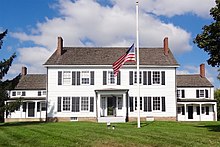Van Horne House
Van Horne House | |
Bridgewater, New Jersey | |
| Coordinates | 40°33′42″N 74°33′5″W / 40.56167°N 74.55139°W |
|---|---|
| Area | 2 acres (0.81 ha) |
| Built | c. 1750 |
| Architectural style | Colonial Revival |
| NRHP reference No. | 02000133[1] |
| NJRHP No. | 3719[2] |
| Significant dates | |
| Added to NRHP | March 8, 2002 |
| Designated NJRHP | December 20, 2001 |
The Van Horne House is a historic building at 941 East Main Street near
History
Between 1683 and 1685, Thomas Codrington, a merchant from New York City, purchased 2,754 acres between the
During the French and Indian War, Philip Van Horne was a colonel in the Somerset County militia. In 1759, he was appointed a judge in the Court of Common Pleas for Somerset County.[7] He was known for his great hospitality, to both sides of the war, and his house became known as Convivial Hall or Convivial Hill.[6][8] Andrew D. Mellick Jr. in his book, The Story of an Old Farm, reports that Van Horne had "five handsome and well-bred daughters who were the much admired toasts of both armies."[9] His eldest daughter, Mary Ricketts, married Irish American Colonel Stephen Moylan on September 12, 1778.[10] American Captain Alexander Graydon (1752–1818) writes that: "His house, used as a hotel, seemed constantly full."[11] and notes that General George Washington was concerned:[12]
I wish you had brought Vanhorne off with you, for from his noted Character, there is no dependance to be placed upon his Parole.
— General George Washington
Mellick writes:[9]
at one time Washington contemplated his removal to New Brunswick. Indeed he was arrested and put on parole, but was permitted to remain at Middlebrook
At the Battle of Bound Brook, on April 13, 1777, Van Horne hosted British General Charles Cornwallis for breakfast and American Generals Benjamin Lincoln and Nathanael Greene for supper.[13]
During the
On October 26, 1779, British Lt. Col. John Graves Simcoe led a group of the Queen's Rangers to search for and capture New Jersey Governor William Livingston or Colonel Moylan. He raided several houses in Bound Brook before arriving here, but did not find his targets. After taking prisoners at the house, he continued on to Van Veghten's Bridge.[15]
In 1934, the house was purchased by the Calco Chemical Company, later American Cyanamid. The company had previously established a large manufacturing facility on the adjoining property, starting in 1916. Starting in 1937, company executive John McMurray had the house restored, "in colonial period", to be used as corporate guest quarters. During World War II, the company noted in its April 1944 newsletter:[3]
Charm notwithstanding in the revolutionary fame of the Van Horne house, Calco workers may be proud that the restored mansion now plays a vital part in the present war by providing the necessary office space for the department responsible for the sale of sulfa-drugs not only to the drug trade but to the armed forces all over the world.
Description
The house is two stories with a gable roof. The stone foundation is from the 18th century. The house was remodeled by the Calco Chemical Company between 1937 and 1944 using a 20th-century Colonial Revival style.[3] It is on a hill north of the Old York Road and west of the Middle Brook.[6]
Gallery
-
Front view, looking north
-
Somerset County historical information
-
Old York Road bronze tablet
-
Plan of theJohann von Ewald
See also
- Other houses used as headquarters during the second Middlebrook encampment(1778–79):
- Wallace House – General George Washington
- Van Veghten House – General Nathanael Greene
- Staats House – General Friedrich Wilhelm von Steuben
- Jacobus Vanderveer House – General Henry Knox
References
- ^ "National Register Information System". National Register of Historic Places. National Park Service. July 9, 2010.
- ^ "New Jersey and National Registers of Historic Places – Somerset County" (PDF). New Jersey Department of Environmental Protection – Historic Preservation Office. February 12, 2018. p. 5.
- ^ a b c d e Bertland, Dennis N. (March 8, 2002). "NRHP Nomination: Van Horne House". National Park Service.
{{cite journal}}: Cite journal requires|journal=(help) "Accompanying 36 photos, from 2001".{{cite journal}}: Cite journal requires|journal=(help) - OCLC 692143813.
- ^ "The Van Horne House". Heritage Trail Association, Bridgewater, NJ.
- ^ Historic American Buildings Survey. pp. 1–15.
- ^ Bergen, James J. (1912). ""Phil's Hill", The Home of Colonel Van Horne". In Honeyman, A. Van Doren (ed.). Somerset County Historical Quarterly. Vol. 1. pp. 81–85.
- ISBN 0-19-518159-X.
- ^ OCLC 2321010.
- ^ Stryker, William Scudder (1903). Documents Relating to the Revolutionary History of the State of New Jersey. p. 452.
- ^ Graydon, Alexander (1846). Littell, John Stockton (ed.). Memoirs of His Own Time. With Reminiscences of the Men and Events of the Revolution. Philadelphia: Lindsay and Blakiston. p. 279.
- ^ Washington, George (January 12, 1777). "From George Washington to Colonel Joseph Reed, 12 January 1777". Founders Online, National Archives.
- ^ "Historical Marker Unveiled at Van Horne House". Somerset County, New Jersey. October 25, 2016.
- ^ Washington, George (February 6, 1779). "General Orders, 6 February 1779". Founders Online, National Archives.
- OCLC 66268501.
External links
- Official website

- Historic American Buildings Survey (HABS) No. NJ-523, "Philip Van Horn House, Somerset Avenue, Bound Brook, Somerset County, NJ", 4 photos, 15 measured drawings, 17 data pages
- HABS No. NJ-525, "Smock-Hodge House, Bound Brook, Somerset County, NJ", 4 photos, 18 measured drawings, 15 data pages – Kells Hall, Island Farm, Cornelius Van Horne House
- "Revolutionary War Sites in Bridgewater, New Jersey". Van Horne House
- "Philip Van Horne House. Circa 1750". The Historical Marker Database.




